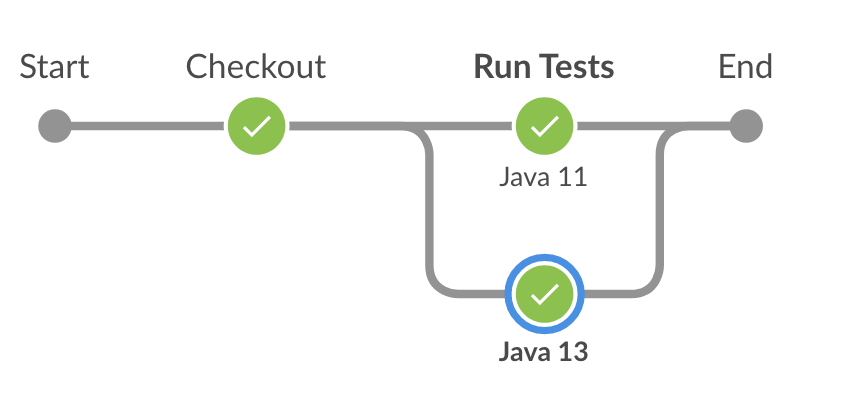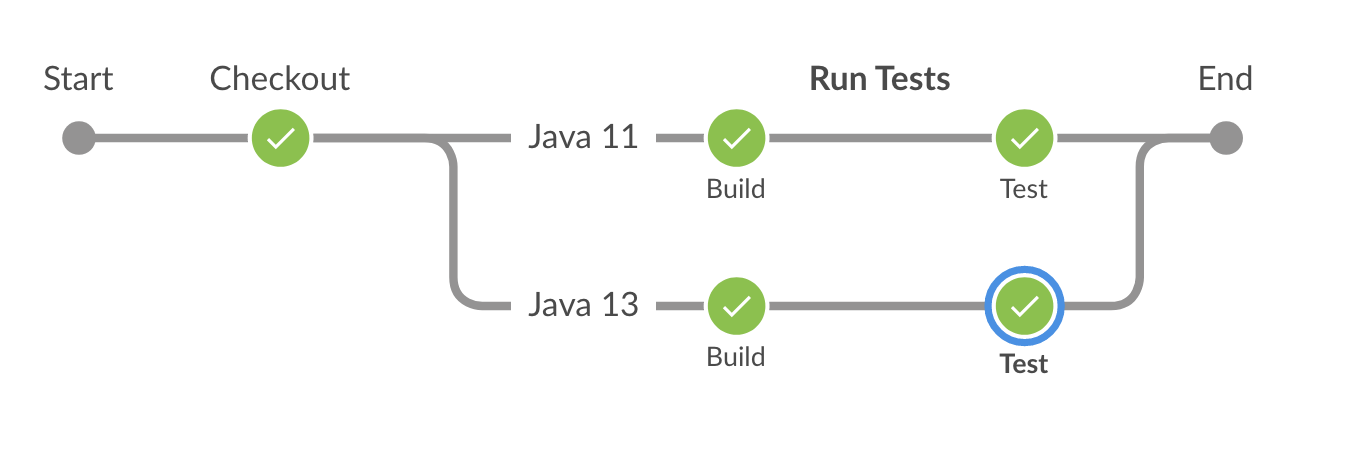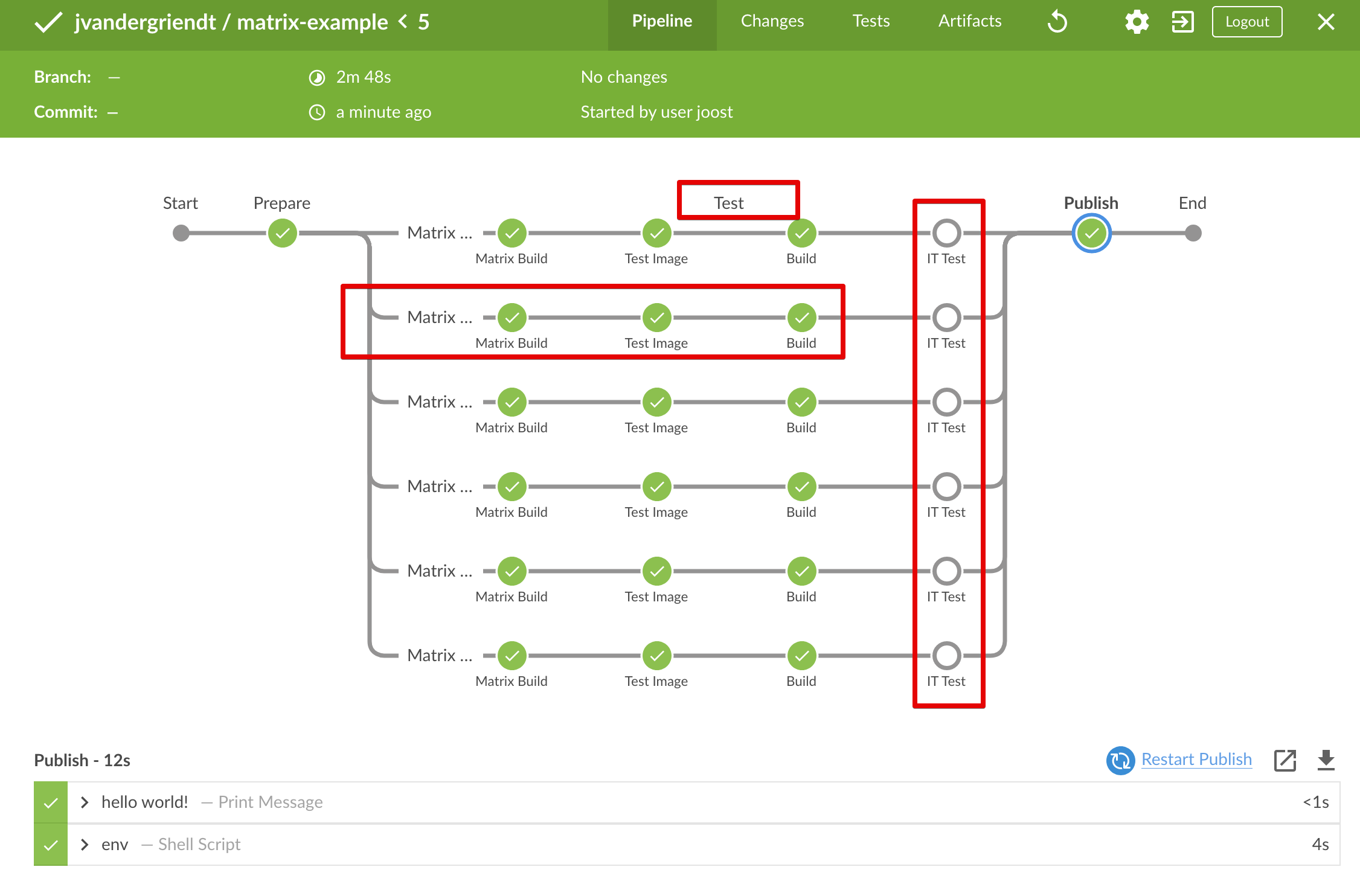Parallel Pipeline¶
Building applications can be fun, but it can also cause a lot of wait time3.
There are many ways to speed up builds, do fewer tests, get bigger and better hardware, or run some tasks in parallel.
Jenkins Pipelines can do parallel stages for a while, even in the Declarative format1.
Although doing parallel pipelines, Jenkins didn't become awesome until Sequential Stages 2. We will dive into the magic of Sequential Stages, but first, let's start with building in parallel.
Parallel Stages¶
This is an elementary example. We have an application we want to build in Java 11 - latest LTS - and the latest version of Java - now Java 13.
As both are running in their own containers, each can leverage its own resources - provided the underlying VM has them available.
pipeline {
agent {
kubernetes {
label 'jx-maven-lib'
yaml """
apiVersion: v1
kind: Pod
spec:
containers:
- name: maven11
image: maven:3-jdk-11
command: ['cat']
tty: true
- name: maven13
image: maven:3-jdk-13
command: ['cat']
tty: true
"""
}
}
stages {
stage('Checkout') {
steps {
git 'https://github.com/joostvdg/jx-maven-lib.git'
}
}
stage('Run Tests') {
parallel {
stage('Java 11') {
steps {
container('maven11') {
sh 'mvn -V -e -C verify'
}
}
}
stage('Java 13') {
steps {
container('maven13') {
sh 'mvn -V -e -C -Pjava13 verify'
}
}
}
}
}
}
}
Visualization¶
This will then look like this:

Sequential¶
Before we dive into all the benefits of Sequential Stages, let's look at how the syntax changes.
With Parallel Stages, we can execute some steps in parallel, but with regards to visualizing individual steps, it is inferior.
Sequential Stages allows us to add Stages in sequence within a Parallel step, which is why I usually call them Parallel Sequential stages.
In summary, the syntax now becomes:
stages {
stage('Checkout') {
stage('Run Tests') {
parallel {
stage('Java 11') {
stages {
stage('Build') {
steps {}
}
}
}
}
}
}
}
The full example:
pipeline {
agent {
kubernetes {
label 'jx-maven-lib'
yaml """
apiVersion: v1
kind: Pod
spec:
containers:
- name: maven11
image: maven:3-jdk-11
command: ['cat']
tty: true
- name: maven13
image: maven:3-jdk-13
command: ['cat']
tty: true
"""
}
}
stages {
stage('Checkout') {
steps {
git 'https://github.com/joostvdg/jx-maven-lib.git'
}
}
stage('Run Tests') {
parallel {
stage('Java 11') {
stages {
stage('Build') {
steps {
container('maven11') {
sh 'mvn -V -e -C package'
}
}
}
stage('Test') {
steps {
container('maven11') {
sh 'mvn -V -e -C test'
}
}
}
}
}
stage('Java 13') {
stages {
stage('Build') {
steps {
container('maven13') {
sh 'mvn -V -e -C -Pjava13 package'
}
}
}
stage('Test') {
steps {
container('maven13') {
sh 'mvn -V -e -C -Pjava13 test'
}
}
}
}
}
}
}
}
}
Visualization¶
The first thing we notice is that we get more indenting and more { }. But, we can also visualize independent stages within the parallel "streams".
If you're thinking, but can't I now do much more with stage individual stages? You're right, and we'll dive into that next.

Sequential With Separate Pods¶
The biggest downside of the previous examples is that the Kubernetes Pod is always there, including all the containers we need.
But what if some parallel tasks take much longer than others? It would be great if the other containers would be removed as soon if we're done with them.
With Sequential stages, we can achieve this. We first set agent none, to make sure we don't have a Pod running from start to finish.
This comes with a price, though, now every stage will need to have its own agent defined. Luckily, combining Parallel and Sequential stages, we can give each parallel "stream" an agent - a Pod - and have each sequential stage use this.
In summary, we do this:
- Pipeline: no agent
- parallel: Build
- stream java 11: agent maven11
- stream java 13: agent maven13
- parallel: Test
- stream java 11: agent maven11
- Functional Tests
- API Contract Tests
- Performance Tests
- stream java 13: agent maven13
- Functional Tests
- API Contract Tests
- Performance Tests
- stream java 11: agent maven11
- Deploy
- parallel: Build
Another benefit is that each stage can leverage every Declarative Directive4, such as when { }5. In this example, we've used when { branch 'master' } to avoid executing steps when we're not on branch master.
To extend this even further, we can now leverage both the dynamic Pod allocation and the When Directive. When combined with beforeAgent true, we won't even spin up the Pod, avoiding unnecessary resource consumption and waiting.
The complete example now looks like this.
pipeline {
agent none
stages {
stage('Build') {
parallel {
stage('Java 11') {
agent {
kubernetes {
label 'jxmavenlib-jdk11_build'
containerTemplate {
name 'maven11'
image 'maven:3-jdk-11'
ttyEnabled true
command 'cat'
}
}
}
steps {
container('maven11') {
sh 'mvn -v'
}
}
}
stage('Java 13') {
agent {
kubernetes {
label 'jxmavenlib-jdk13-build'
containerTemplate {
name 'maven13'
image 'maven:3-jdk-13'
ttyEnabled true
command 'cat'
}
}
}
steps {
container('maven13') {
sh 'mvn -v'
}
}
}
}
}
stage('Test') {
parallel {
stage('Java 11') {
agent {
kubernetes {
label 'jxmavenlib-jdk11-test'
containerTemplate {
name 'maven'
image 'maven:3-jdk-11'
ttyEnabled true
command 'cat'
}
}
}
stages {
stage('Functional Tests') {
steps {
echo 'Hello'
}
}
stage('API Contract Tests') {
steps {
echo 'Hello'
}
}
stage('Performance Tests') {
when {
branch 'master'
}
steps {
echo 'Hello'
}
}
}
}
stage('Java 13') {
agent {
kubernetes {
label 'jxmavenlib-jdk13-test'
containerTemplate {
name 'mavenjdk11'
image 'maven:3-jdk-13'
ttyEnabled true
command 'cat'
}
}
}
stages {
stage('Functional Tests') {
steps {
echo 'Hello'
}
}
stage('API Contract Tests') {
steps {
echo 'Hello'
}
}
stage('Performance Tests') {
when {
branch 'master'
}
steps {
echo 'Hello'
}
}
}
}
}
}
stage('Deploy') {
agent {
kubernetes {
label 'jxmavenlib-deployment'
containerTemplate {
name 'pl_deployment'
image 'cloudbees/docker-java-with-docker-client'
ttyEnabled true
command 'cat'
}
}
}
when {
branch 'master'
beforeAgent true
}
steps {
echo "hello"
}
}
}
}
Visualization¶
When visualized, we can spot which stages are skipped due to the when {} Directives.

Sequential With Optional & Reusable Pods¶
We're not done yet — one more step to take.
While dynamically allocating Pods with containers sounds excellent, it comes at a cost. If you do something in the build phase and you need the data in the latest stages, you've now lost it - new Pod = new workspace.
There are a few things you can do, but none of them pretty. You can use stash6 and unstash[ˆ7], but these can be very costly in terms of I/O performance and time.
Alternatively, you can either look for externalizing your workspace or keep the Pod around for reuse.
Important
If you can run more than one build at the same time - concurrent builds - you run the risk of having builds claim Pods another build has done work in.
To avoid builds reusing Pods from other runs, you can disable concurrent builds.
Alternatively, you can encode the build number into the name:
Pod Reuse¶
To reuse a Pod, we have to override some default values in the PodTemplate10.
idleMinutes: Allows the Pod to remain active for reuse until the configured number of minutes has passed since the last step was executed on it.
The configuration below means the Pod can be idle for about 5 minutes before it gets deleted. Additionally, we changed the label not to include the phase name. Otherwise, we cannot get the same Pod.
agent {
kubernetes {
idleMinutes 5
label 'jxmavenlib-jdk11'
yaml """
spec:
containers:
- name: maven11
image: maven:3-jdk-11
command: ['cat']
tty: true
"""
}
}
Volume For Externalizing Workspace¶
There are various ways to externalize your workspace, you can leverage NFS8 or Jenkins workspace related plugins9.
One way we'll look at here is to leverage a PersistedVolume in Kubernetes - which could be of any kind, incl NFS8.
We add a volume of type persistentVolumeClaim and point to an existing one by claimName.
volumeMounts:
- name: build-cache
mountPath: /tmp/cache
volumes:
- name: build-cache
persistentVolumeClaim:
claimName: azure-managed-disk
azure-managed-disk-pvc.yaml
Full Example¶
pipeline {
agent none
options {
disableConcurrentBuilds()
}
stages {
stage('Build') {
parallel {
stage('Java 11') {
agent {
kubernetes {
idleMinutes 5
label "jxmavenlib-jdk11-b${BUILD_NUMBER}"
yaml """
spec:
containers:
- name: maven11
image: maven:3-jdk-11
command: ['cat']
tty: true
volumeMounts:
- name: maven-cache
mountPath: /root/.m2/repository
- name: build-cache
mountPath: /tmp/cache
volumes:
- name: maven-cache
hostPath:
path: /tmp
type: Directory
- name: build-cache
persistentVolumeClaim:
claimName: azure-managed-disk
"""
}
}
steps {
git 'https://github.com/joostvdg/jx-maven-lib.git'
container('maven11') {
sh 'mvn -V -e -C verify'
sh 'cp -R target/ /tmp/cache/'
sh 'ls -lath /tmp/cache/'
}
}
}
stage('Java 13') {
agent {
kubernetes {
idleMinutes 5
label "jxmavenlib-jdk13-b${BUILD_NUMBER}"
yaml """
spec:
containers:
- name: maven13
image: maven:3-jdk-13
command: ['cat']
tty: true
volumeMounts:
- name: maven-cache
mountPath: /root/.m2/repository
volumes:
- name: maven-cache
hostPath:
path: /tmp
type: Directory
"""
}
}
steps {
git 'https://github.com/joostvdg/jx-maven-lib.git'
container('maven13') {
sh 'mvn -V -e -C -Pjava13 verify'
}
}
}
}
}
stage('Test') {
parallel {
stage('Java 11') {
agent {
kubernetes {
idleMinutes 5
label "jxmavenlib-jdk11-b${BUILD_NUMBER}"
yaml """
spec:
containers:
- name: maven11
image: maven:3-jdk-11
command: ['cat']
tty: true
volumeMounts:
- name: maven-cache
mountPath: /root/.m2/repository
- name: build-cache
mountPath: /tmp/cache
volumes:
- name: maven-cache
hostPath:
path: /tmp
type: Directory
- name: build-cache
persistentVolumeClaim:
claimName: azure-managed-disk
"""
}
}
stages {
stage('Functional Tests') {
steps {
container('maven11') {
sh 'ls -lath /tmp/cache'
sh 'cp -R /tmp/cache/ .'
sh 'ls -lath'
}
}
}
stage('API Contract Tests') {
steps {
echo 'Hello'
}
}
stage('Performance Tests') {
when {
branch 'master'
}
steps {
echo 'Hello'
}
}
}
}
stage('Java 13') {
agent {
kubernetes {
idleMinutes 5
label "jxmavenlib-jdk13-b${BUILD_NUMBER}"
yaml """
spec:
containers:
- name: maven13
image: maven:3-jdk-13
command: ['cat']
tty: true
volumeMounts:
- name: maven-cache
mountPath: /root/.m2/repository
volumes:
- name: maven-cache
hostPath:
path: /tmp
type: Directory
"""
}
}
stages {
stage('Functional Tests') {
steps {
container('maven13') {
sh 'ls -lath'
}
}
}
stage('API Contract Tests') {
steps {
echo 'Hello'
}
}
stage('Performance Tests') {
when {
branch 'master'
}
steps {
echo 'Hello'
}
}
}
}
}
}
stage('Deploy') {
agent {
kubernetes {
label 'jxmavenlib-deployment'
containerTemplate {
name 'pl_deployment'
image 'cloudbees/docker-java-with-docker-client'
ttyEnabled true
command 'cat'
}
}
}
when {
branch 'master'
beforeAgent true
}
steps {
echo "hello"
}
}
}
}
Matrix¶
In late 2019, Jenkins released the Matrix Build feature. It extends the Parallel and Sequential features and allows you to create a Matrix of options for parallel execution.
If you want to get a more in-depth look at this feature, I recommend reading Liam Newman's11 excellent introductory blog post.
When you've read this and Liam's posts, I recommend you go through the 12 test cases of the Matrix build feature on GitHub. They provide a wealth of information and worked-out examples.
What Is It¶
The Matrix build feature extends the Parallel and Sequential features mentioned earlier in this article. What it allows you to do is to specify multiple sets of values (axis), and then execute each entry of the cartesian product13.
Matrix acts as a special stage type, and can include an agent{} and stages{} definition.
Axis¶
The mechanism for specifying the sets of values is called axis.
You start by specifying the matrix build within a stage.
Within matrix you specify the axis with one or more axis.
matrix {
axes {
axis {
name 'JDK_VERSION'
values '8','11', '13'
}
axis {
name 'JDK_TYPE'
values 'ibmjava','amazoncorretto', 'jdk'
}
}
}
In this case, we will get these nine combinations:
- jdk + 8, jdk + 11, jdk + 13
- ibmjava + 8, ibmjava + 11, ibmjava + 13
- amazoncorretto + 8, amazoncorretto + 11, amazoncorretto + 13
Exclusions¶
Unfortunately, several of these are not valid combinations. The ibmjava only has a JDK 8 version, and the default (open)JDK is the only one with a JDK 13 version (at this time).
You can filter these out with a when directive, but that would pollute the pipeline view. Wouldn't it be better to ensure the invalid combinations aren't even considered?
You can tell the matrix build feature just that, by setting exclusions.
You start with an exclusions {} followed by one or more exclusion{} blocks.
Let's exclude JDK 11 from IBM's java.
excludes {
exclude {
axis {
name 'JDK_VERSION'
values '11'
}
axis {
name 'JDK_TYPE'
values "ibmjava"
}
}
}
Sometimes, you want to limit a combination to a single axis. Meaning, exclude every combination of x, except for y.
We can do just that, by specifying notValues in the exclusion. Let's ensure only jdk will be paired with 13.
exclude {
axis {
name 'JDK_VERSION'
values '13'
}
axis {
name 'JDK_TYPE'
notValues 'jdk' // double negative, make sure we only do 13 with jdk
}
}
Together With PodTemplates¶
As with previous examples of the Parallel and Sequential features, Matrix adds an extra dimension to using PodTemplates.
Remember the structure of a Matrix?
It means we can structure of the Sequential stages, by adding a stages {} block and a single agent{} block for those stages.
Because the PodTemplate properties are variables, the values we put in there can be dynamic. This means we can leverage the axis values as input for which container images to use for our PodTemplate.
matrix {
axes {}
agent {
kubernetes {
label "maven-${JDK_TYPE}-${JDK_VERSION}-test"
containerTemplate {
name 'maven'
image "maven:3-${JDK_TYPE}-${JDK_VERSION}"
ttyEnabled true
command 'cat'
}
}
}
stages {}
}
Visual Representation¶
In the visual representation, we can the benefits of the Sequential stages with Matrix. Each axis combination will have its own set of stages, which can also have their own when{} directives.

Complete Example¶
pipeline {
agent none
stages {
stage('Prepare') {
agent {
kubernetes {
label "maven"
containerTemplate {
name 'maven'
image "maven"
ttyEnabled true
command 'cat'
}
}
}
steps {
println 'hello world!'
container('maven') {
sh 'env'
}
}
}
stage('Test') {
matrix {
axes {
axis {
name 'JDK_VERSION'
values '8','11', '13'
}
axis {
name 'JDK_TYPE'
values 'ibmjava','amazoncorretto', 'jdk'
}
}
excludes {
exclude {
axis {
name 'JDK_VERSION'
values '13'
}
axis {
name 'JDK_TYPE'
notValues 'jdk' // double negative, make sure we only do 13 with jdk
}
}
exclude {
axis {
name 'JDK_VERSION'
values '11'
}
axis {
name 'JDK_TYPE'
values "ibmjava"
}
}
}
agent {
kubernetes {
label "maven-${JDK_TYPE}-${JDK_VERSION}-test"
containerTemplate {
name 'maven'
image "maven:3-${JDK_TYPE}-${JDK_VERSION}"
ttyEnabled true
command 'cat'
}
}
}
stages {
stage('Test Image') {
steps {
println "Using Image: maven:3-${JDK_TYPE}-${JDK_VERSION}"
}
}
stage("Build") {
steps {
sh 'uname -a'
git 'https://github.com/joostvdg/jx-maven-lib.git'
container('maven') {
sh 'mvn clean verify --show-version --strict-checksums -e'
}
}
}
stage("IT Test") {
when {
branch 'master'
}
steps {
echo "WE SHOULD NEVER GET HERE"
}
}
}
}
}
stage('Publish') {
agent {
kubernetes {
label "maven"
containerTemplate {
name 'maven'
image "maven"
ttyEnabled true
command 'cat'
}
}
}
steps {
println 'hello world!'
container('maven') {
sh 'env'
}
}
}
}
}